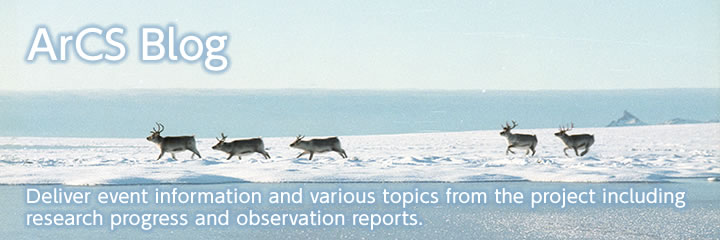Mass loss of the Greenland ice sheet could lead not only to sea level rise, but also to abrupt changes in the global climate and ocean circulations. In order to know the variability of the Greenland ice sheet and climate, we have been participating in an international ice coring project (East Greenland Ice Core Project, EGRIP) and collaborating with Denmark, the US, Norway, etc. As a preliminary study for the ice core analyses, I joined the 2016 summer field campaign to carry out the snow study around ice core drilling site (75°62’68”N 35°99’15”W). Our Japanese research team consisted of two researchers from NIPR.

To understand vertical structure of atmosphere, we carry out radiosonde observation four times per day.
Radiosonde observation does not only help us understand the atmospheric circulation but also improve performance of weather forecast over the Northern Hemisphere.
St Lawrence Island is located in the Northern Bering Sea and is home to 2 million seabirds. The aim of our fieldwork was to establish a marine meso-predator research program in this under-studied region and collect key information on the physiology and foraging ecology of breeding seabirds.
After returning from Bowdoin Glacier, we organized a workshop to discuss with people from Qaanaaq village on 25th July. The aim of this workshop was to report our research activities, learn from the locals about the impact of climate change on their society, and discuss sustainable future of Qaanaaq. Through the workshop, we intended to exchange our experiences and ideas for collaborative relationship in the future. As many of the people do not use English, we arranged interpreter between Greenlandic and English.
We encountered the developed cyclone along the coast of Barrow in Alaska.
The sea level pressure rapidly dropped, strong wind exceeding 18m/s dominated on R/V Mirai while the cyclone passed.
The sea raged due to strong wind, wave height of ocean exceeded 4m.
Two week have passed since we arrive in Arctic Ocean.
Temperature falls below 0 degrees.
With the close cooperation of JAPAN AIRLINES, our group has been conducting atmospheric observations of greenhouse gases in the upper air at the northern high latitudes, using passenger aircraft. I would like to introduce our air sampling performed in the aircraft flying between Japan and Europe.
R/V Mirai arrives at the Arctic Ocean, currently sailing along the coast of Barrow in Alaska. The ship encountered multi-year ice near Barrow after her way through the Chukchi sea with Arctic sea ice.
During a period from August 20 to October 5, 2016, an oceanographic research vessel “MIRAI” owned by Japan Agency for Marine-Earth Science and Technology (JAMSTEC) will conduct observational cruise in the Arctic Ocean. We visited Shimizu port on August 9th to install measurement systems of the atmospheric greenhouse gases to the R/V MIRAI.
Around the middle of September every year, the Arctic sea ice extent reaches its lowest point in the year. According to the data from JAXA’s Earth Observation satellite "SHIZUKU" (GCOM-W1), the minimum extent for this year is expected to be the second lowest in the satellite record. The Arctic sea ice extent graph provided by Arctic Data archive System (ADS) shows that the extent for the beginning of September is already lower than the minimum extent in 2007, which has been the second lowest until now.




